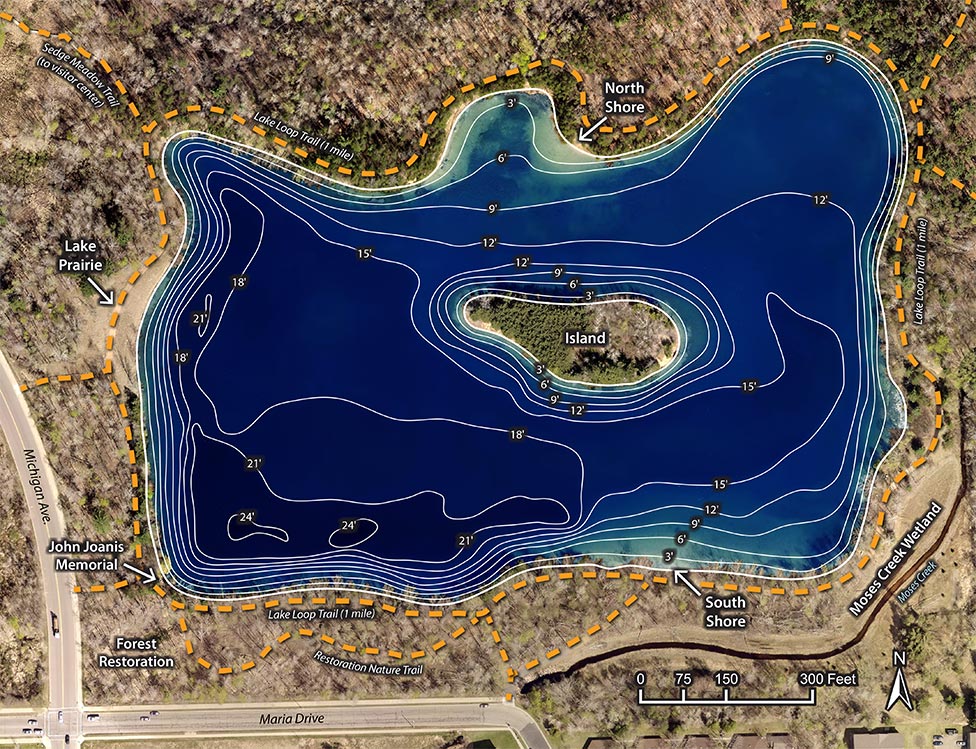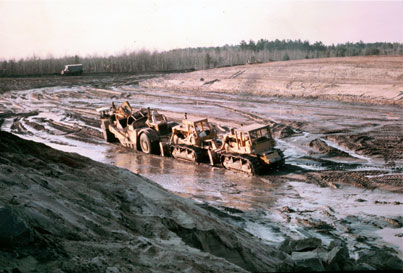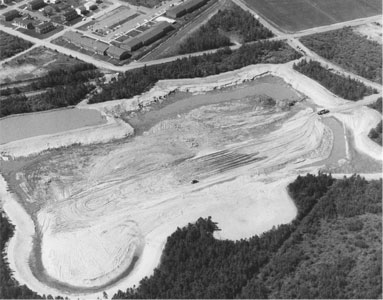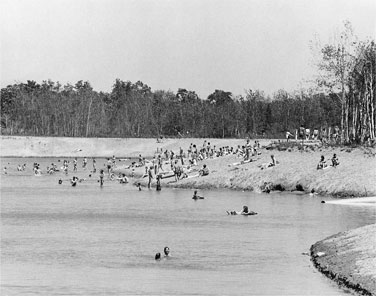-
Type: Excavated seepage lake, fed primarily by groundwater
-
Surface area: 24 acres (including the island), 23 acres (without the island)
-
Maximum depth: 24 feet (in the southwest corner)
-
Common game fish: Northern Pike, Largemouth Bass, Black Crappie, Bluegill, Pumpkinseed, Green Sunfish, Rock Bass, Black and Yellow Bullhead, Whitesucker
Lake Joanis Depth Map
This bathymetric map was produced in the summer of 2018 using over 3,000 data points from a GPS unit and sonar depth finder.

 Download a high-quality Adobe Acrobat PDF map for printing
Download a high-quality Adobe Acrobat PDF map for printing
History of Lake Joanis

Lake Joanis being excavated, 1975
The creation of Lake Joanis in 1975-76 was a catalyst that led to the establishment and protection of Schmeeckle Reserve.
The lake was the dream of Lee Sherman Dreyfus, who served as President and Chancellor of UW-Stevens Point from 1967 to 1977 (he became Wisconsin's 40th governor in 1978). Shortly after taking office, Dreyfus called for the creation of a lake to improve the aesthetics of the campus area. According to Dreyfus, "I feel that the Good Lord and the glacier bypassed us . . . And now we have to find a way to do something to break the absolute flatness of our campus."
In 1966, the newly formed UW-Stevens Point Foundation purchased 50 acres northeast of the main campus for future use by the university. The original plan was to build senior student apartments on the land, but Dreyfus felt that this would be an ideal location to excavate a lake, "where students could go and be away from campus and vehicles." Unfortunately, there was little funding available for such an extensive construction project.
In 1973, John Joanis, Sentry Insurance President and CEO (1966-1984), announced that the company would build its new world headquarters on land north of the university. The building project would require a substantial amount of fill. Dreyfus immediately began meeting with Joanis to discuss the possibility of excavating the fill from the nearby UWSP Foundation property.
An agreement was made was made in 1974 among Sentry Insurance, the UWSP Foundation, and the City of Stevens Point. Sentry would cover the cost of excavating the lake in exchange for using the fill in their headquarters project. The City would cover costs of realigning Moses Creek around the lake. The university would fund all shoreline and recreational improvements. An Environmental Impact Assessment Report developed in December 1974 revealed that the subsurface soils and groundwater characteristics of the site would be conducive to the lake construction.

Aerial view of Lake Joanis under construction, 1975
Construction of the lake began in spring of 1975 and was completed by spring of 1976. The lake was designed by the Warzyn Engineering and Service Company (Madison, Wisconsin) with input from several UW-Stevens Point Biology and Natural Resources faculty. Trucks running day and night carried nearly 19,000 truckloads of fill from the lake site to the Sentry headquarters building, accumulating a total of 540,000 cubic yards. The original design had no island. By January 1976, however, it became apparent that the fill needed for Sentry had been overestimated. In order to maintain a depth of 23 feet in the lake (important for fish life), Dreyfus and Joanis agreed that portions of the lake would be dug deeper and the extra fill would be built into an island. Additional fill was layered onto the athletic fields across Michigan Avenue and piled into a "ski hill" near the Granite Parkway shelter. Moses Creek was rerouted around the southeast corner of the lake to avoid contamination from upstream sources that might cause algae blooms.
As the lake began slowly filling with groundwater in the summer of 1976, hundreds of swimmers flocked to this new oasis. The heavy use prevented the establishment of vegetation on the sandy shoreline and led to erosion problems. Water sampling showed a significant increase in phosphorus and fecal coliform bacteria caused by swimmers.
Duane Gruel was hired as the first manager of the conservancy area in May 1977 by the UWSP Foundation. He led a team of about 15 workers employed under the federal Comprehensive Employment and Training Act (CETA) program. In July 1977, the lake area was closed to all recreation activities in order to establish shoreline vegetation. Gruel led his crew in filling erosion gullies, seeding grasses, laying boulders, transplanting trees and shrubs, and developing trails. By October 1977, hikers and joggers were allowed to use the new trails around the lake, but swimming was prohibited to protect the water quality. Thomas Aten took over the management of the CETA team in November 1977 and continued to plant shrubs and trees around the lake, improve trails, and work on shore stabilization until August 1978.

Swimmers in Lake Joanis, 1977
On July 17, 1978, in a ceremony at the lake, the UWSP Foundation officially donated their 50 acres (which now contained the lake) to the University of Wisconsin Board of Regents, making it part of the UW-Stevens Point campus. This donation was used as a match to acquire a $248,000 Federal Land and Water Conservation Fund (LAWCON) grant that would fund trail development, native landscaping, shelters, and benches in the newly created Schmeeckle Reserve. Acting Chancellor John B. Ellery said that the establishment of the Reserve was "one of the most important accomplishments of UWSP in its history."
On July 1, 1979, Ron Zimmerman was hired as the first director of Schmeeckle. He led the LAWCON grant priorities, which included defining the trail around the lake, constructing fences, benches, and signs to protect the lakeshore, stabilizing the shoreline, and planting native trees and shrubs on the shore and island. Over the years, the trees and vegetation have grown to create the natural appearance that was originally envisioned for the lake area.
For many years, the lake didn't have a formal name—it was usually referred to as either Dreyfus Lake or University Lake. At a ceremony on September 17, 1994, the lake was officially named
Lake Joanis in honor of John Joanis, the former Sentry Insurance President who had paid for its excavation. Joanis died in 1985, but his wife, Marian, and Lee Sherman Dreyfus attended the ceremony. According to Dreyfus, "While the lake was my dream, without John Joanis it would not exist. He made it happen."
The legacy of Dreyfus' dream and Joanis' action, along with all of the visionary university and community partners, lives on in the crown jewel of Schmeeckle Reserve. The lake is a focal point for students, faculty, community members, and visitors. According to recent trail counter data, over 90,000 people walk, jog, or bicycle around the lake every year.
To see more historic photos of the lake being constructed, visit the
Lake Joanis photo gallery.
Mary Williams was Special Assistant to Chancellor Dreyfus starting in 1976. She worked diligently to make the dream of Dreyfus' lake and the creation of a protected nature reserve become a reality.
Read her essay, "Don't Let It Be a Mud Puddle," to learn more.
Lake Joanis Research
The Lake Joanis Management Plan (updated in 2015) can be viewed here.
Lake Joanis Management Plan (updated in 2015) can be viewed here.
The
Portage County Lakes Study website provides a comprehensive report (2005) about the Lake Joanis' water quality, algae, rooted aquatic plants, shoreline vegetation, critical amphibian habitat, land use, and groundwater.
Other research conducted on the lake can be viewed on the
Schmeeckle Reserve Research Studies web page.
